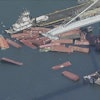Engineering and manufacturing businesses are constantly subject to risk, whether these are external volatilities and natural disasters or political unrest. By 2030, DHL has estimated that the annual global economic impact of natural disasters could be up to €328 billion. At the same time, and according to DHL’s risk management platform Resilience 360, civil unrest remains a major risk in 30 percent of all countries whilst even outside of the Middle East incidences of terrorism have increased by 59 percent in the past year.
So what role can the supply chain play in helping to manage these risks? The World Economic Forum has suggested that significant disruption to the supply chain is likely to impact a company’s share price by 7 percent on average. E&M businesses should prioritize supply chain risk management by preparing for predicting and managing risk in the supply chain.
Preparation is Key – Get Ready to Face Risks Today
The supply chain is central to the success of any large-scale engineering and manufacturing business. Without this strong backbone, operations can be subject to more significant disruption and external volatilities are more likely to have a devastating effect. Businesses should assess the impact of risk and consider what steps should be taken to prevent significant disruption. Having a contingency plan in place should be a priority — and businesses should insist that their suppliers are equally as prepared.
Engineering and manufacturing businesses across the industry are often made up of complex, global networks. This is where supply chain transparency comes in — visibility makes it easier to understand where products are, how shipments could be disrupted and what must be done to mitigate for this.
Look to the Future – Predict the Potential of a Crisis
Supply chain risk management works best when companies have the earliest possible notice of potentially disruptive incidents. Data analysis is a key element. By analysing past data, engineering and manufacturing businesses can develop a better understanding of what risks they might face at any given time, and ensure they are protected in the future.
Data should be centralized across the business so that it can be most effectively analysed. It is important that communication across divisions is fluid to enable this and collaboration should therefore be encouraged. Businesses should also run simulations on their supply chain to understand the pressure points and likely threats.
Taking on the Challenge – Managing Risk in Your Supply Chain
Sometimes it is inevitable that disruption will impact the supply chain. As we have seen, the global geopolitical landscape today is highly volatile. Whilst it is important that companies prepare for and predict the effects of disruption, crucially businesses need to manage risk when it strikes. Again, communication across the business, and also with suppliers, is imperative as employees need to react quickly, but carefully, during a crisis.
Businesses that are well prepared will have necessary and robust data on hand. Their supply chain will be transparent so they will understand where the risk might have the greatest impact. Together this will help them to manage challenging situations quickly and efficiently.
Ensuring Your Supply Chain is Ready for Risk
Ultimately, businesses will never completely avoid disruption but if they prepare they can potentially reap rewards. Companies that get supply chain risk management right have a strong foundation on which to develop their overall risk management strategy. With it, they can often gain advantage by filling the gaps left by their less-agile competitors. By investing in more resilient supply chains, E&M businesses will not only reduce the impact of disruptive events, they will also have the potential to boost overall business performance.
Reg Kenney is President of DHL Engineering and Manufacturing.



















